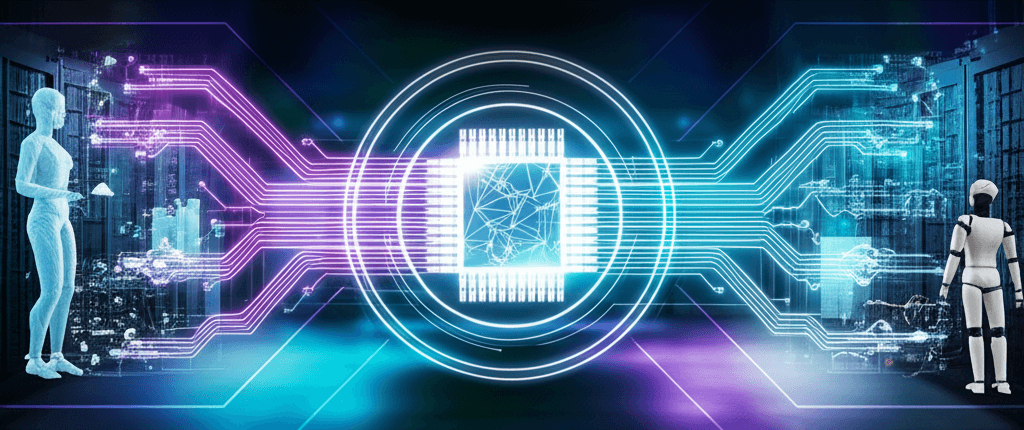Nvidia Pushes Physical AI Frontier, Building Next Generation of Smart Machines
Nvidia unveils an end-to-end ecosystem for Physical AI, bringing intelligent machines from virtual training into the real world.
August 11, 2025

Nvidia is aggressively pushing the frontier of artificial intelligence beyond the digital realm and into the physical world, unveiling a comprehensive suite of new hardware, software, and advanced AI models aimed at creating a new class of intelligent machines. At the SIGGRAPH 2025 conference, the company articulated a clear and ambitious vision for "Physical AI," a concept describing the deep integration of AI and computer graphics to power robotics, autonomous vehicles, and smart infrastructure.[1] This strategic push is underpinned by the release of more accessible Blackwell-based enterprise servers, powerful new foundation models for reasoning and synthetic data generation, and significant updates to its Omniverse simulation platform, all designed to bridge the gap between virtual training and real-world deployment.
The foundation of this initiative is a significant expansion of Nvidia's Blackwell architecture into the enterprise data center. The company announced the Nvidia RTX PRO 6000 Blackwell Server Edition GPU will be available in the widely adopted 2U mainstream server form factor from partners including Cisco, Dell Technologies, HPE, Lenovo, and Supermicro.[1][2][3] This move is designed to accelerate the transition from traditional CPU-based data centers to GPU-accelerated computing platforms, making the immense power of the Blackwell architecture more accessible to enterprises worldwide.[4] Nvidia claims these new systems can deliver up to a 45-fold increase in performance and an 18-fold improvement in energy efficiency compared to CPU-only systems for a range of workloads from data analytics to AI inference.[1][2][5][6] These servers incorporate fifth-generation Tensor Cores with support for the FP4 data format, which can boost inference performance by up to six times compared to the previous-generation L40S GPU.[1][6] By packing this power into a standard 2U rack, Nvidia is effectively lowering the barrier to entry for companies to build their own on-premise "AI factories," providing the necessary computational backbone for developing and running complex physical AI applications.[2][4]
Powering the intelligence of these future systems are new, highly sophisticated AI models. Nvidia has expanded its Nemotron family with the introduction of Nemotron-4 340B, an open-access large language model with 340 billion parameters.[7][8] Trained on a massive dataset of 9 trillion tokens encompassing over 50 natural languages and 40 programming languages, its primary purpose is not just to answer questions but to serve as a powerful engine for synthetic data generation.[7][9] The model and its associated pipeline can create high-quality, labeled training data that developers can use to build and customize their own smaller, more specialized AI models for a fraction of the cost and time of manual data collection.[10][9] Critically, Nvidia revealed that over 98% of the data used for the model's own alignment process was synthetically generated, a testament to the pipeline's effectiveness.[9][8] Complementing this is the new Cosmos Reason, a 7-billion-parameter Vision Language Model (VLM) specifically designed for physical AI.[2] While traditional VLMs allow machines to "see" and identify objects, Cosmos Reason gives them the ability to reason about the physical world, a crucial step towards creating robots that can understand and execute complex, multi-step tasks in unpredictable environments.[2][11]
These hardware and software advancements converge within Nvidia's Omniverse platform, the virtual environment where physical AI is born and refined. Omniverse acts as a physics-based, digital twin ecosystem where developers can simulate, test, and validate robots and autonomous systems before deploying them in the real world.[12][13] New updates announced at SIGGRAPH enhance this capability, including software development kits that improve data interoperability with robotics development tools like MuJoCo and new NuRec libraries that use 3D Gaussian splatting to reconstruct real-world scenes with stunning accuracy from sensor data.[14][15][16] This entire ecosystem directly supports Nvidia's Project GR00T (Generalist Robot 00 Technology), a foundation model for creating general-purpose humanoid robots.[17][18] The strategy is circular and self-improving: Cosmos can be used to generate endless permutations of realistic, physically accurate virtual environments within Omniverse.[13] The GR00T models are then trained and tested on this vast trove of synthetic data, learning skills at a scale and speed impossible in the real world.[17] This entire computationally demanding cycle is powered by the new Blackwell systems, enabling a development pipeline that can slash training times from months to mere days.[19][17]
Ultimately, the flurry of announcements at SIGGRAPH 2025 paints a picture of a company building a complete, end-to-end platform for the next wave of artificial intelligence. Nvidia is no longer just a chipmaker; it is an architect of an entire ecosystem for embodied AI. By integrating increasingly powerful and accessible Blackwell hardware with advanced reasoning models like Nemotron and Cosmos and a sophisticated simulation engine in Omniverse, Nvidia is providing the tools to create a feedback loop where AI trained in simulation can be rapidly and effectively deployed into the physical world. This strategic convergence of hardware, software, and AI models aims to dramatically accelerate the development of smarter, more capable robots and autonomous systems, potentially igniting what the company's leadership calls the next industrial revolution.[1][19]
Sources
[3]
[7]
[10]
[11]
[13]
[14]
[15]
[16]
[17]
[18]
[19]